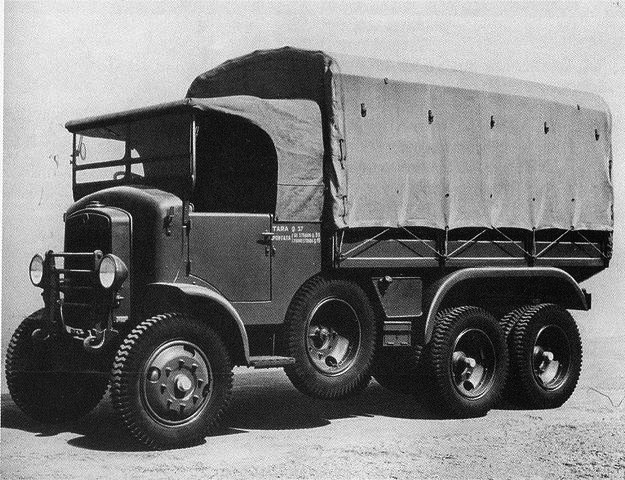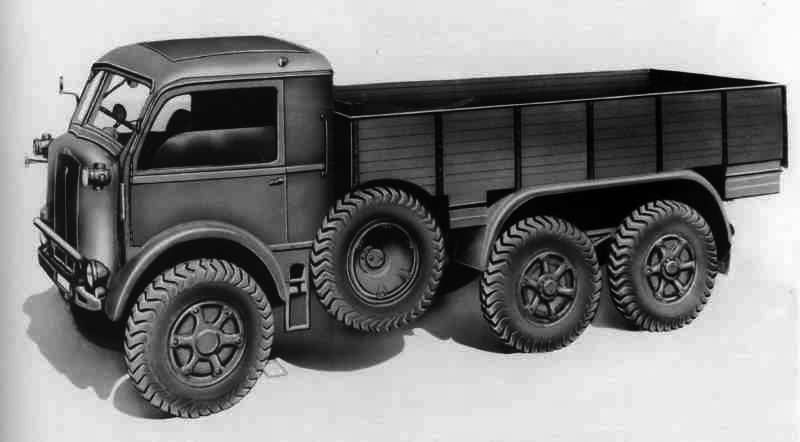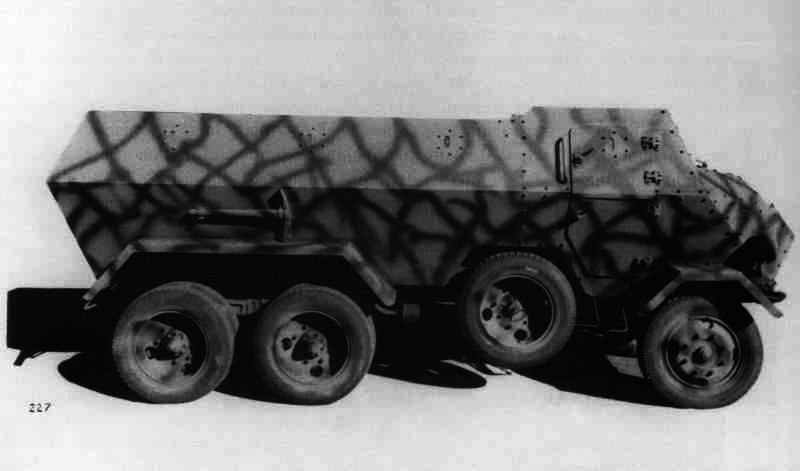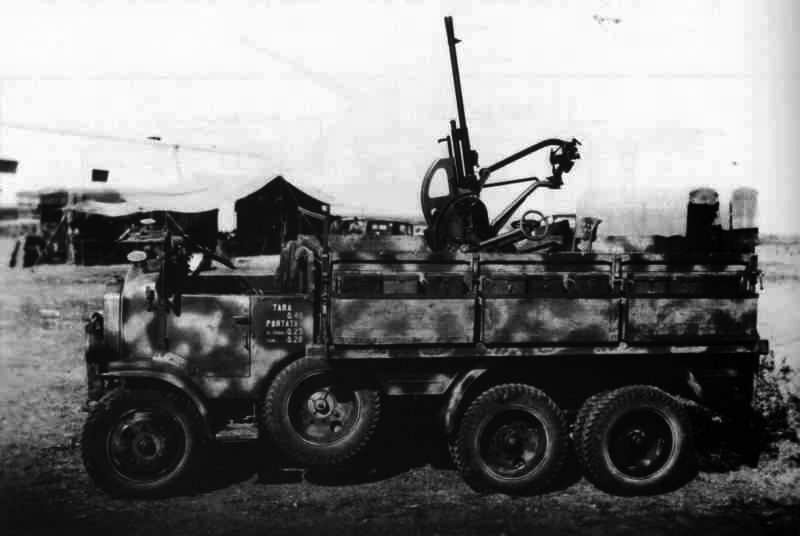S.P.A. Dovunque 35
 Italy (1935-45) - 6x6 Truck - 2000? built
Italy (1935-45) - 6x6 Truck - 2000? built
Design
Development
 Fiat Dovunque 33
Fiat Dovunque 33
In 1935 Fiat modified its Fiat Dovunque 33 to remedy the critical issues that emerged during the Ethiopian War. In September the prototype of the new Dovunque was presented at the Motorization Study Center of the Royal Army. The vehicle was received positively and in 1936 Fiat entrusted the production of the SPA Dovunque 35 to one of its subsidiaries. A version with a closed cabin was also acquired by the Regia Aeronautica.
The Dovunque 33 was pioneered after the 1931 Fiat Veicoli Industriali developed the Fiat 612 truck, based on the Fiat 611 C (Coloniale) three-axle lorry for colonial, giving birth also to the Fiat 611 armored car. The Royal Army decided to the 612 as the Dovunque 33, the name "dovunque" (go anywhere) indicated its off-road capabilities. It was deployed with artillery regiments for command and liaison and with the Regia Aeronautica with a 120 mm photoelectric projector for AA batteries. In 1935, 82 were deployed in the Ethiopian War, where mobility was confirmed but the engine proved underpowered, handling difficult. These reports were sent to Fiat, which by September 1935 presented the prototype of a revised version. It was accepted to be produced by the Società Piemontese Automobili (SPA) as the Dovunque 35, replacing the 33.
Design modifications
 Dovunque 35 Autocarro
Dovunque 35 Autocarro
The Fiat Dovunque 33 layout was taken from the Fiat 611 C, chassis with longitudinal members, three axles, first steering, rear twin driving wheels. The latter could even mount a pair of tracks. The wheelbase was 2,700 mm/1000 mm the a front 1,470 mm track, 1,500 mm rear. Two spare wheels were placed 250 mm from the ground between the first and second axles. The initial 33 engine was Fiat 122B petrol engine, a 6-cylinder 2953 cm³ rated at 46 hp at 2400 rpm with cardan transmission, 4+1 speed gearbox, reducer/differential, for a 8+2 and "cab over engine" configuration, two seats in the cabin with folding canvas roof. The 33 could carry 20 soldiers/2000 kg payload.
On the 35, chassis and bodywork were those of the 33 but the engine, was now the 4-cylinder 4053 cm³ petrol Fiat-SPA 18T, rated for 55 hp at 2000 rpm, for a top speed of 60 km/h and precious extra torque when negociating bad terrain. Suspensions also were much strengthened, although still leaf-springed. Brakes used an hydraulic pedal acting on all six wheels, one hand acting on the transmission. Empty weight rose to 4,530 kg, payload to 2,500 kg. The body wooden sides were closed unlike for the Dovunque 33 (spaced boards).
Variants
 Dovunque Protetto
Dovunque Protetto
 Dovunque 35 with Breda AA
Dovunque 35 with Breda AA
- Basic version, 2500 kg payload/25 equipped infantry.
- Regia Aeronautica version with rigid closed cabin.
- Autocannon version with a Breda 20/65 Mod. 1935 AA.
- Mobile observation tower version Mod. 41.
- Dovunque-Viberti Centro Radio version*
- Mobile Photographic Laboratory version
- SPA Dovunque 35 protetto: APC produced in 1944.
- Dovunque 41***
*Cabin version from Viberti, equipped with Magneti Marelli RF2 CA and R6[1] radios, operating in long, medium and short waves, with a radius of 500, 1000 and 5000 km respectively.
**In 1941 SPA had further developed the project, creating the SPA Dovunque 41, produced both in the heavy off-road truck version and in the heavy artillery tractor version.
In service
The Dovunque received its baptism of fire in the Spanish Civil War. In June 1940, the Dovunque 35 was massively employed on all fronts, but assigned in priority to the Italian North African units, the theater for which it was designed. Many ended also on the Russian front for the same reasons. It was mainly used for towing light artillery but was declined in several versions (see above).
After the Armistice of Cassibile in September 1943, production in the north was maintained under control of the Germans, and 307 more were delivered, adopted by the Wehrmacht. But Production resumed until 1948. The Italian Army kept it frontline until 1950. By then US trucks became the new standard. Many ended for years afterwards in the civilian sector, helping in mountainous areas and for specialty works or forestry services.
Links about the Dovunque 35
Gli Autoveicoli del Regio Esercito nella Seconda Guerra Mondiale, Nicola Pignato, Storia Militare.
Gli Autoveicoli tattici e logistici del Regio Esercito Italiano fino al 1943, tome II, Nicola Pignato e Filippo Cappellano, 2005.
Vanderveen, Bart (1989). Historic Military Vehicles Directory.
La Radio In Grigio Verde, Galasso e Gaticci, 1992
kfzderwehrmacht.de
Review on onthewaymodels.com
Blindato on Tank Encyclopedia
Fiat Dovunque 33
SPA Dovunque 35 wikipedia.it
on wikipedia.en
Amatori, Franco; et al. (1992). Storia della Lancia — Impresa Tecnologie Mercati 1906–1969. Milan.
Dovunque 35 specifications |
| Dimensions | 5,030 x 2,070 x 2,910 m |
| Total weight, battle ready | 4,530 kg |
| Crew | 2+20 troops |
| Propulsion | Fiat 18T petrol, 4 cyl. 4053 cm³ 55 hp |
| Top speed | 60 km/h |
| Range | 100 l gas. tank, 290 km |
| Payload | 2,500 kgs |
| Transmission & suspension | 6x4 leaf springs, 4+1/8+2 gearbox |
| Armament | None, see variants |
| Production | Unknown, c2000 1936-48 |